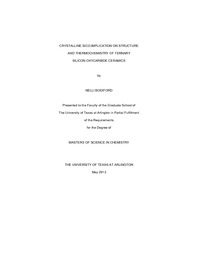
ATTENTION: The works hosted here are being migrated to a new repository that will consolidate resources, improve discoverability, and better show UTA's research impact on the global community. We will update authors as the migration progresses. Please see MavMatrix for more information.
Show simple item record
| dc.contributor.author | Bodiford, Nelli | en_US |
| dc.date.accessioned | 2014-09-17T17:29:52Z | |
| dc.date.available | 2014-09-17T17:29:52Z | |
| dc.date.issued | 2014-09-17 | |
| dc.date.submitted | January 2013 | en_US |
| dc.identifier.other | DISS-12092 | en_US |
| dc.identifier.uri | http://hdl.handle.net/10106/24741 | |
| dc.description.abstract | The need for innovative refractory materials - materials that can sustain extreme temperatures - has been constantly growing within the modern industries. Basic requirements for usage at ultra-high-temperatures have been considered such as high melting point, high structural strength, exceptional resistance to oxidation, zero or almost zero creep. Monolithic ceramics alone cannot provide these properties, therefore, composite materials are sought to fulfill the demand. For example, silicon nitride and silicon carbide based ceramics have long been leading contenders for structural use in gas turbine engines. In the course of this work we are investigating amorphous SiCO formed via polymer-to-ceramic route. Previously a considerable amount of work has been done on structures of stoichiometric amorphous SiCO and a "perfect" random network was obtained (experimentally as well as supported by computational work) up to the phase content of 33 mol-% SiC. By "perfect" one assumes to have four fold coordinated Si atoms bonded to C and O; C atoms bond to Si atoms only and O is two fold connected to Si. Beyond 33 mol-% SiC within SiCO phase the structural imperfections and defects start to develop. Aside from the stoichiometric form of SiCO, the polymer-to-ceramic route allows for the incorporation of high molar amounts of carbon to create SiCO ceramic with excess carbon. The incorporation of carbon into silica glass improves high-temperature mechanical properties and increases resistance to crystallization of the amorphous material. The amount of `free carbon' can be controlled through the choice of precursors used during synthesis. There were no ternary crystalline phases of SiCO observed. However, in systems such as MgO-SiO2, Na2O-Al2O3-SiO2 there are ternary crystalline compounds (MgSiO3, Mg2SiO4, NaAlSiO4, NaAlSi3O8) that are of a greater energetic stability than glasses of the same composition. What makes the SiCO system different? In the approach proposed in this work for studying the SiCO system we work with crystalline models. These are well-ordered structures that approximate essential details of a disordered phase. The crystalline models are generated by using recently introduced structure search algorithms: AIRSS (Ab Initio Random Structure Prediction Search) and USPEX (Universal structure predictor: Evolutionary Xtallography). Then the models are further optimized in a standard ab-initio total-energy and molecular dynamics program VASP (Vienna Ab-initio Simulation Package) using pseudopotentials, plane waves, and the generalized gradient approximation (GGA). Structures of the targeted compositions start with 10 mol-% of SiC within SiCO up to 66 mol-%. In addition to stoichiometric models, we also analyzed structures with "free" carbon. The excess energy was calculated from the difference between the energy of the model and the energy of a combination of phase assembly composed of β-SiC, q-SiO2 and graphite.As the result, this work presents SiCO crystalline models, their microstructure, crystallographic description of each structure, energetic stability compared to amorphous models as well as the phase diagrams including Gibbs energy calculations to estimate thermodynamic stability. | en_US |
| dc.description.sponsorship | Kroll, Peter | en_US |
| dc.language.iso | en | en_US |
| dc.publisher | Chemistry & Biochemistry | en_US |
| dc.title | Crystalline SiCO: Implication On Structure And Thermochemistry Of Ternary Silicon Oxycarbide Ceramics | en_US |
| dc.type | M.S. | en_US |
| dc.contributor.committeeChair | Kroll, Peter | en_US |
| dc.degree.department | Chemistry & Biochemistry | en_US |
| dc.degree.discipline | Chemistry & Biochemistry | en_US |
| dc.degree.grantor | University of Texas at Arlington | en_US |
| dc.degree.level | masters | en_US |
| dc.degree.name | M.S. | en_US |
Files in this item
- Name:
- Bodiford_uta_2502M_12092.pdf
- Size:
- 8.162Mb
- Format:
- PDF
This item appears in the following Collection(s)
Show simple item record


